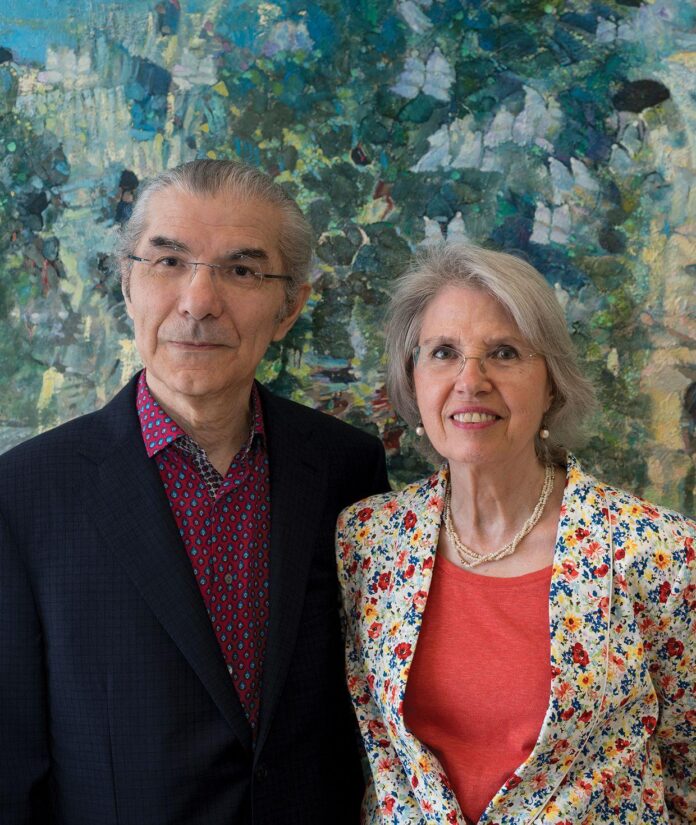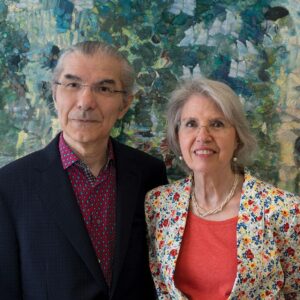The dealer and collector behind a major donation of works to the Arab World Institute in Paris (Institut du Monde Arabe, IMA) says he does not “expect a dime from the donation” because of a cast-iron guarantee that the items will never be disposed of.
The donation of 1,677 works by 148 artists from the collection of the French-Lebanese dealer and collector Claude Lemand and his wife France has triggered plans for a new museum space at the Institute. In June 2018, 1,300 works from the collection were accepted by the IMA board of directors, followed by 377 works in June last year. A gallery named for the couple will be dedicated to showing works from their donation.
The gift includes works by Abdallah Benanteur from Algeria, Shafic Abboud from Lebanon and Dia Al-Azzawi from Iraq. Other artists represented in the collection include Simone Fattal of Syria, Nasser Al-Aswadi of Yemen, the late Egyptian sculptor Adam Henein and Kamel Yahiaoui of Algeria.
Jack Lang, the chairman of the Arab World Institute, announced earlier this year that it will open the new “civilisation and art museum“ after a two-year renovation of its Jean Nouvel-designed building. It will be the first pan-Arabic art museum in the West, becoming the first “defacto Museum of Arab art from antiquity to the present in Europe, and even in the West”, according to a museum statement. Lang, whose mandate ends in March, is seeking reappointment for a fourth term.

The first pan-Arabic art museum in the West will be housed across seven levels of the Arab World Institute located on the banks of the Seine in Paris © Thierry Rambaud
Claude Lemand tells The Art Newspaper: “The IMA museum is ‘a museum of France’ [‘musée de France’ is an official government assignation], signifying that anything that comes into the museum can never be deaccessioned, unlike in US museums. Jack Lang has the same vision as us, under French law… we have the guarantee that the works of our donations will be exhibited in the new museum by annual rotation, and no work from our collection could ever leave the IMA museum.”
Lemand runs two galleries in Paris, having set up the business in 1988, and was one of the “first [Western] gallerists to embark on promoting major Arab artists who had settled in the West”, according to the gallery website. “It was in Egypt that we made our first acquisitions: we bought from Aïda Ayoub
Lemand reveals the terms of the arrangement with the IMA, which was first signed in October 2018 and amended in January, throwing light on how the new museum will be structured. “The name Espace [space] Claude & France Lemand will be given to the only space of the museum where modern and contemporary works of art from its collection will be exhibited in rotation… which includes works reflecting the significance of the Claude & France Lemand donation.”
Terms and conditions
Other terms state that the IMA will make available the Lemand works from the collection for the purpose of organising exhibitions in the other spaces in the museum, in its temporary exhibition spaces or on loan to other institutions, in France and worldwide. “The text, donation of Claude & France Lemand, must appear on the labels of the works exhibited at the IMA and in other institutions, as well as in the captions of the published works.”
The IMA has also promised to “provide [the] donors, and their heirs, with an annual activity report, including the management and promotion of the works in the museum’s collection”. A plaque at the entrance to the IMA museum will be displayed with the following inscription: “The IMA museum is infinitely grateful to Claude and France Lemand.”
The French Ministry of Culture will contribute €6m to transform the IMA building, which should start in a year’s time. The Institute, which is an intergovernmental foundation of France and member of the League of Arab States, has a collection of 2,500 modern and contemporary works including the Lemand collection, 900 antiquities and manuscripts, and 4,500 photographs dating from the 19th century onwards.
The new museum will occupy parts of all seven levels of the building on the banks of the Seine. Its director, Nathalie Bondil, former head of the Montreal Museum of Fine Arts, intends to unveil cross-cultural galleries spanning periods throughout history, from Neolithic and Mesopotamian times to the present.
She says she wishes to show how “Arab culture is part of our culture” through “a long overdue recognition of the Arab civilisation”. Special focus will be given to Palestinian art and the role of women in arts and music.
“The vision seems clear and good, especially with the focus on Palestine and women,” says Venetia Porter, honorary research fellow and former curator of Islamic and contemporary Middle Eastern art at the British Museum in London.


























